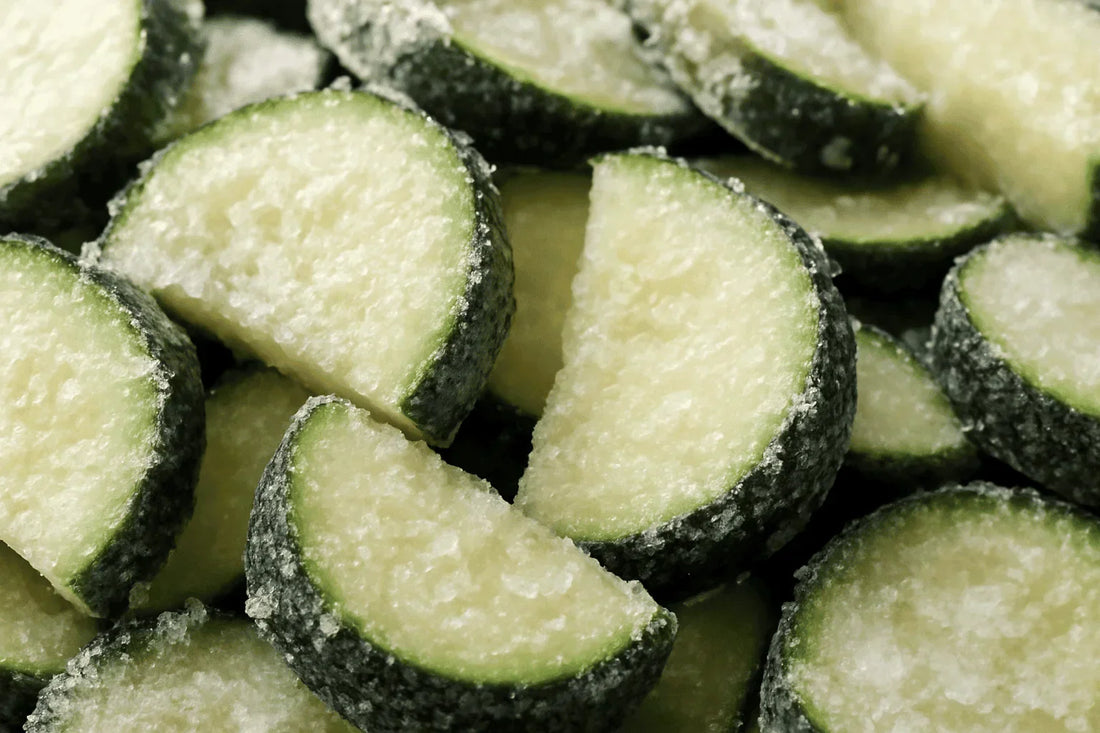
Can You Freeze Zucchini? Everything You Need to Know
Teilen
Summer gardens overflow with zucchini, and home cooks everywhere find themselves wondering what to do with the abundance. This versatile vegetable transforms everything from bread and muffins to stir-fries and casseroles, but even the most creative cook can feel overwhelmed by the sheer volume of zucchini that plants produce.
The good news? Freezing offers an excellent solution for preserving this nutritious vegetable while maintaining its flavor and nutritional benefits.
Many people hesitate to freeze zucchini, worried about texture changes or loss of taste. However, with the right techniques, frozen zucchini can be just as delicious and useful as fresh. Whether you're dealing with a garden harvest or simply want to take advantage of seasonal prices at the grocery store, knowing how to properly freeze zucchini opens up a world of meal-planning possibilities.
Why Freezing Zucchini is a Smart Idea
Let's be honest - zucchini can be tricky to manage when you have too much of it. But freezing this versatile vegetable makes perfect sense for several reasons.
Preserving Freshness and Nutrients
Freezing zucchini at peak ripeness locks in essential vitamins and minerals. This simple preservation method keeps most of the vegetable's nutritional value intact:
- Vitamin C for immune system support
- Potassium for heart health
- Folate for cell function
- Antioxidants that fight inflammation
- Fiber for digestive health
The trick is understanding that zucchini has lots of water in it. While this makes it refreshing when fresh, it also means you need to prepare it properly before freezing. When you do it right, frozen zucchini keeps its nutritional benefits and works great in recipes all year long.
Convenience for Busy Schedules
Having frozen zucchini ready to go makes cooking so much easier. Instead of washing, peeling, and cutting fresh zucchini every time you cook, you just grab what you need from the freezer. This is especially helpful when you're rushing to get dinner on the table.
Pre-cut frozen zucchini works perfectly in soups, stews, casseroles, and baked goods. You can toss it right into many dishes without thawing first, which is perfect for those "what's for dinner?" moments. The time you save means less stress and more time to actually enjoy cooking.
Reducing Food Waste
Nobody likes throwing away good food, and zucchini plants can produce way more than any family can eat fresh. Freezing gives you a practical way to use every bit of your harvest or grocery store haul. You're basically extending the life of your zucchini from days to months.
This trick also helps you save money. When zucchini goes on sale during peak season, you can buy extra and freeze it for later. That way, you have a steady supply without paying premium prices during off-season months.
Don't worry about frozen zucchini turning mushy or losing its taste. That usually happens when people don't use the right freezing techniques. When you do it properly, frozen zucchini tastes great and works beautifully in cooked dishes.

How to Properly Freeze Zucchini: Step-by-Step Guide
The process might seem involved, but it's actually pretty straightforward once you get the hang of it. Here's how to freeze zucchini the right way.
Preparing Zucchini for Freezing
First, pick firm, fresh zucchini without any soft spots or weird marks. Give each one a good wash under cool water, scrubbing gently to get rid of dirt. You can peel them if you want, but keeping the skin on gives you extra nutrients and fiber.
Cut your zucchini based on how you plan to use it later:
- Slice into rounds for stir-fries and side dishes
- Cube for soups and stews
- Shred for baking, like zucchini bread or muffins
- Cut into sticks for snacking or roasting
Try to make your pieces about the same size so they freeze and cook evenly. If you're working with bigger zucchini, scoop out the seeds since they can make things watery when frozen.
Blanching Process
Blanching is really important for keeping your zucchini's color, texture, and flavor during freezing. It's basically a quick boil followed by an ice bath, and it stops the natural processes that would make your zucchini go bad in the freezer.
Here's what you do: bring a big pot of water to a rolling boil. Add your zucchini pieces and cook them for just 1-2 minutes if they're sliced, or 3 minutes if they're cubed. The timing depends on how thick your pieces are, but don't overcook them or you'll end up with mush. The zucchini should still be slightly crisp when you take it out.
Cooling and Draining
Right after blanching, dump your zucchini into a bowl of ice water to stop the cooking process. This quick cooling prevents overcooking and helps the vegetable keep its structure. Leave the zucchini in the ice water for the same amount of time it was blanched.
Drain everything really well using a colander, then pat dry with clean kitchen towels or paper towels. Getting rid of extra moisture prevents ice crystals from forming during freezing, which can ruin the texture. If you're working with shredded zucchini, squeeze out even more moisture using clean kitchen towels.
Freezing Zucchini
Pack your prepared zucchini in freezer-safe containers or bags, and squeeze out as much air as possible to prevent freezer burn. A vacuum sealer works best, but pressing air out of freezer bags works fine, too. Leave a little headspace in rigid containers so the zucchini can expand.
Don't forget to label your packages with what's inside and the date you froze it. Make portion sizes that match how you usually cook to avoid waste. Laying bags flat in the freezer saves space and makes thawing quicker when you need it.
How to Store Frozen Zucchini for Long-Term Use
Once your zucchini is frozen, proper storage makes all the difference in maintaining quality over time.
Storage Tips and Organization
Good labeling and organization make frozen zucchini so much easier to use. Use a permanent marker to clearly write what's in each package, how much, and when you froze it. This system helps you use older packages first and prevents confusion.
Here are some simple storage tips:
- Store packages in the coldest part of your freezer (usually the back or bottom)
- Keep similar items together for easy access
- Use freezer baskets or bins to stay organized
- Check your freezer temperature stays at 0°F (-18°C) or below
- Don't overload your freezer - air needs to circulate properly
Storage Duration Guidelines
Frozen zucchini tastes best when you use it within 8-12 months. It's still safe to eat after that, but the texture and flavor might not be as good. Using a first-in, first-out system helps make sure you're always using the best quality zucchini.
Every few months, check your frozen zucchini for signs of freezer burn or ice crystals. This means air got in somehow, and you should use those packages soon. Properly sealed packages should stay good throughout the whole recommended storage time.
Preventing Freezer Burn
Freezer burn happens when air hits frozen food, causing it to dry out and lose quality. The good news is it's totally preventable with the right packaging. Start by eliminating air exposure with proper sealing. Double-wrapping or using vacuum-sealed bags gives you extra protection.
Keep your freezer at a steady 0°F (-18°C) or below. Temperature changes cause ice crystals to form, which hurts the quality. Don't pack your freezer too full either - air needs room to circulate and keep everything at the right temperature.
Creative Ways to Use Frozen Zucchini
Frozen zucchini excels in cooked applications where texture changes are less noticeable. Add it directly to soups, stews, and casseroles without thawing. The vegetable will cook quickly and blend seamlessly with other ingredients.
Baking represents another excellent use for frozen zucchini. Thawed and drained zucchini works perfectly in bread, muffins, and cakes. The slight texture change actually helps distribute moisture evenly throughout baked goods.
Smoothies benefit from frozen zucchini's mild flavor and creamy texture. Add small amounts to fruit smoothies for extra nutrition without altering taste significantly. The frozen state eliminates the need for additional ice while providing valuable nutrients.

Making the Most of Your Frozen Zucchini
Understanding proper thawing techniques ensures the best results when using frozen zucchini. For most cooking applications, thawing isn't necessary. However, when recipes require thawed zucchini, drain the excess moisture that accumulates during thawing.
Consider your cooking methods when deciding how to prepare zucchini for freezing. Shredded zucchini works best for baking, while sliced or cubed pieces suit savory dishes better. Having variety in your freezer provides flexibility for different recipes.
Conclusion
Freezing zucchini offers tremendous benefits for home cooks seeking convenience, nutrition, and waste reduction. This preservation method allows you to enjoy summer's bounty year-round while maintaining the vegetable's essential nutrients and versatility. The key to success lies in proper preparation, including blanching, draining, and packaging techniques that preserve quality during storage.
With frozen zucchini in your freezer, meal planning becomes more flexible and efficient. Whether you're making a quick weeknight dinner or preparing baked goods for special occasions, having this nutritious vegetable readily available opens up countless culinary possibilities. The techniques outlined here ensure that your frozen zucchini maintains excellent quality and flavor for months of enjoyable cooking.
Take advantage of seasonal abundance or grocery store sales by learning these freezing techniques. Your future self will appreciate having nutritious, convenient zucchini available whenever inspiration strikes in the kitchen.

